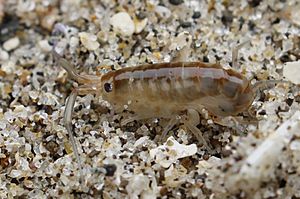Bellorchestia quoyana facts for kids
Quick facts for kids Bellorchestia quoyana |
|
|---|---|
 |
|
| Conservation status | |
|
Not evaluated (IUCN 3.1)
|
|
| Scientific classification | |
| Kingdom: | |
| Phylum: | |
| Subphylum: | |
| Class: | |
| Order: | |
| Family: |
Talitridae
|
| Genus: |
Bellorchestia
|
| Species: |
B. quoyana
|
| Binomial name | |
| Bellorchestia quoyana (H. Milne-Edwards, 1840)
|
|
| Synonyms | |
|
|
Bellorchestia quoyana is a type of sandhopper. It used to be called Talorchestia quoyana. This sandhopper is the biggest and most common kind found only in New Zealand.
It can grow up to 14 millimeters long. These amazing creatures help keep beaches clean. They do this by breaking down dead plants and other natural materials. This process is super important for new plants to grow on the beach. Bellorchestia quoyana is active at night. During the day, it buries itself in the sand, sometimes as deep as 30 centimeters. The drier the sand, the deeper it goes!
What Does It Look Like?
Bellorchestia quoyana can grow up to 29 millimeters long. Male sandhoppers are usually a little bigger than females. Their bodies are often light yellowish-brown. They have marbled patterns of darker brown. This helps them blend in with the sand.
They have one pair of black eyes. They also have two different pairs of antennae. The first pair of antennae is short. It reaches just past the first joint of the second antennae. The second pair is stronger and longer. In females, it extends past their head and the first three body parts. In males, it can be over half their body length! The second part of these antennae is twice as long as the first.
How Do They Jump?
Sandhoppers can jump! They balance on their third-to-last pair of legs. Then, they tuck their abdomen (the back part of their body) underneath. The end of their uropods (tail-like parts) and telson (a small plate) press onto the ground. When they suddenly straighten their abdomen, they are pushed into the air. When they land, their abdominal limbs and the last two pairs of legs act like shock absorbers. This helps to cushion their landing.
Where Do They Live?
Bellorchestia quoyana lives on sandy beaches. You can find them all around the coasts of New Zealand.

